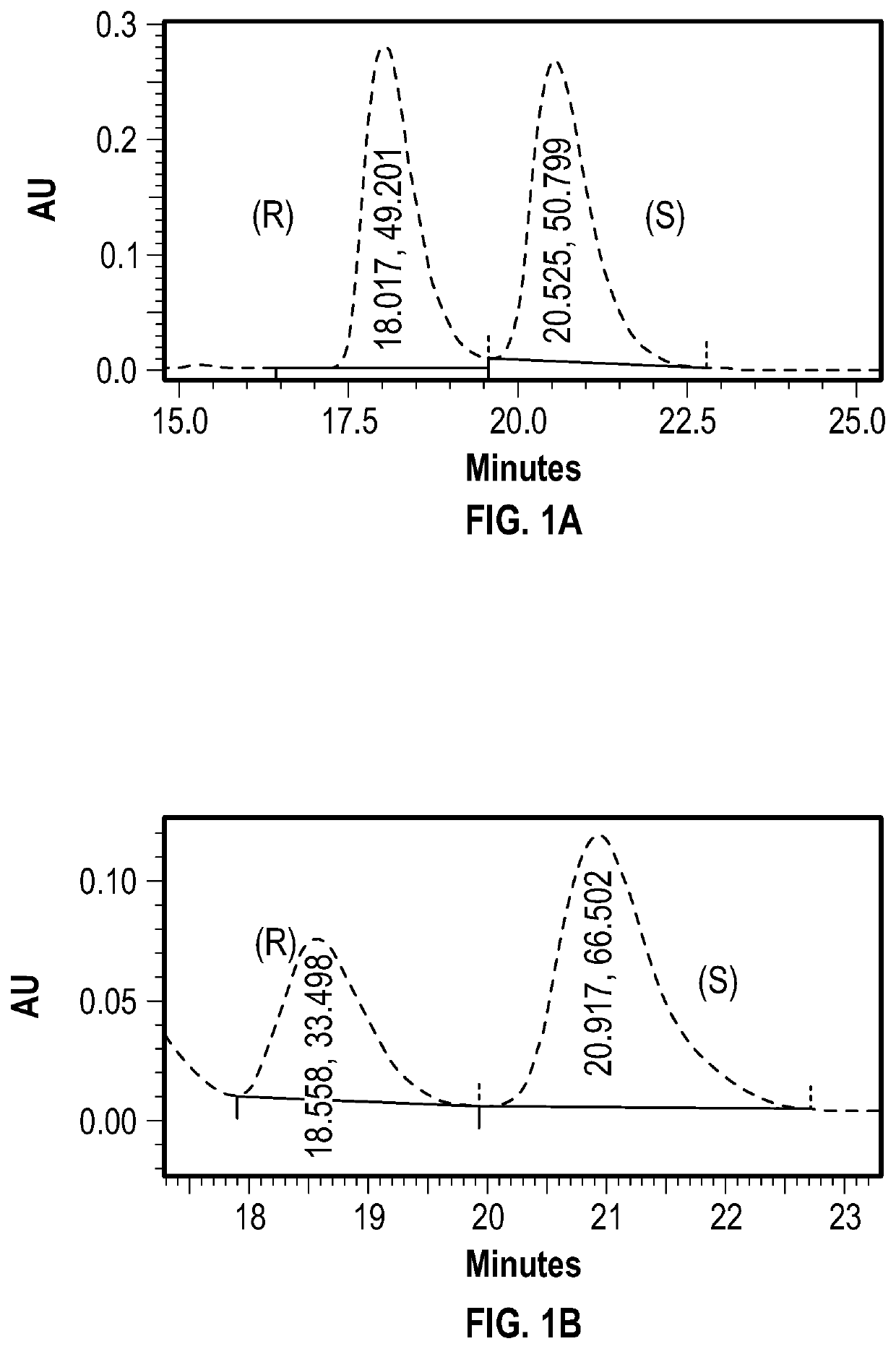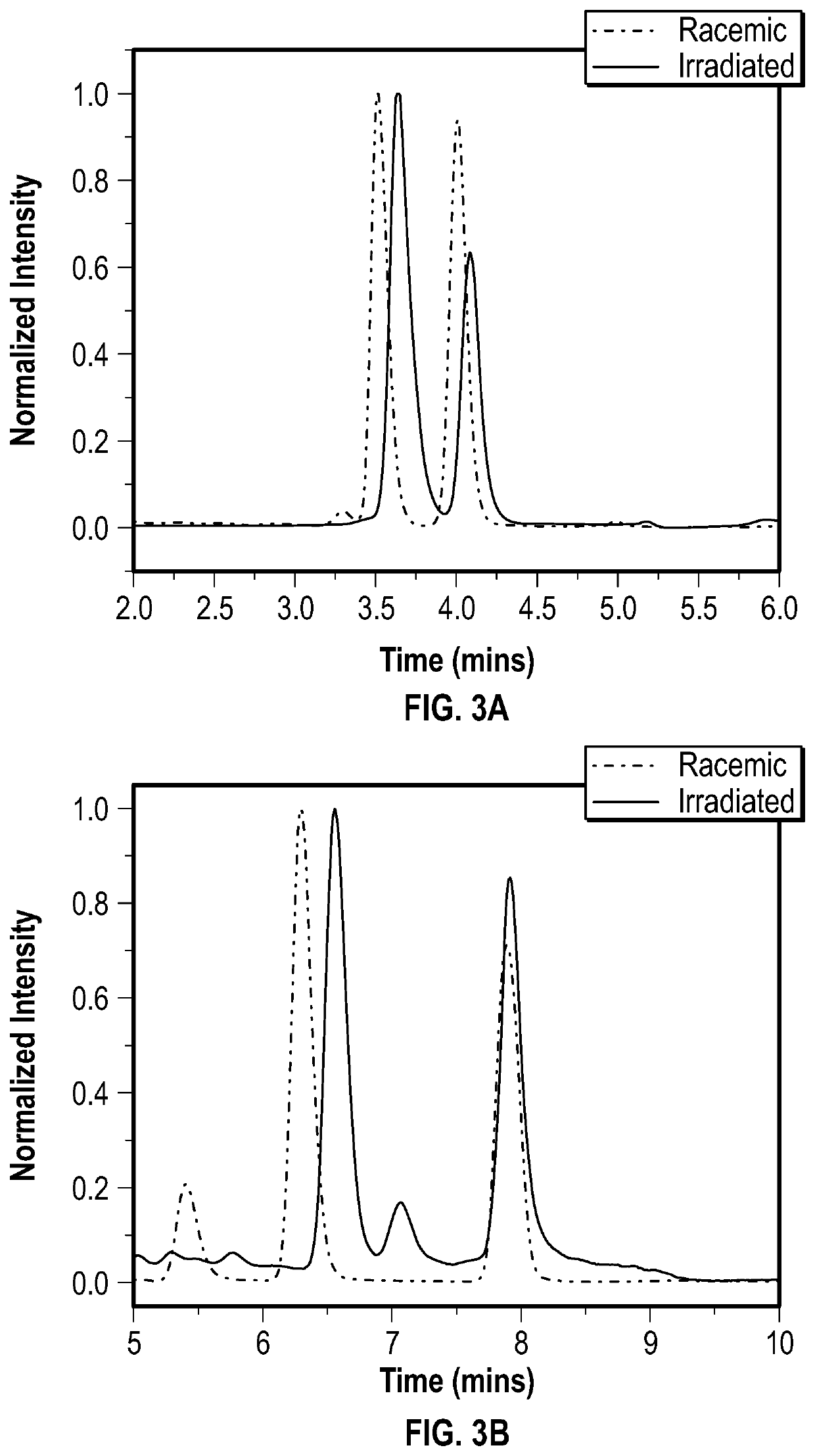Atropisomers and methods of altering enantiomeric excess
a technology of enantiomeric excess and atropisomers, which is applied in the preparation of carbamic acid derivatives, amino-carboxyl compound preparations, organic chemistry, etc., can solve the problem of formation of a racemic mixture of (r) and (s) isomers
- Summary
- Abstract
- Description
- Claims
- Application Information
AI Technical Summary
Benefits of technology
Problems solved by technology
Method used
Image
Examples
example 1
[0094]To a flame-dried 50 mL 3-neck flask was added 0.35 mmol of (S)-camphor sulfonyl chloride. The flask was evacuated and backfilled with N2 three times and submerged in an ice bath.
[0095]5 mL of a 0.07 M solution of racemic [1,1′-binaphthalene]-2,2′-diol (BINOL) (0.35 mmol) in anhydrous dichloromethane (DCM) was cooled to 0° C. in an ice bath and added via syringe to the flask under positive N2 pressure.
[0096]0.121 mL of anhydrous trimethylamine (TEA) was then added to the reaction flask.
[0097]The mixture was stirred under N2 and allowed to return to room temperature over 12 hours. The reaction was quenched with 5 mL of H2O, stirred for 15 minutes, and extracted three times with DCM. The organic layer was then washed with brine, and dried over Na2SO4.
[0098]Liquid was removed under vacuum to yield a yellow waxy solid.
[0099]
[0100]A silica column was prepared using 12 g of 400-600 mesh silica, wet packed with hexanes. The crude product was dissolved in 0.5 mL o...
example 2
[0102]To a flame-dried 50 mL 3-neck flask was added 0.35 mmol of (R)-menthyl chloroformate. The flask was evacuated and backfilled with N2 three times, and submerged in an ice bath.
[0103]5 mL of a 0.07 M solution of racemic BINOL (0.35 mmol) in anhydrous dichloromethane (DCM) was cooled to 0° C. in an ice bath, and added via syringe to the flask under positive N2 pressure.
[0104]0.121 mL of TEA was then added to the reaction flask. The mixture was stirred under N2 and allowed to return to room temperature over 3 hours.
[0105]The reaction was quenched with 5 mL of 1M HCl, stirred for 15 minutes, and extracted three times with DCM. The organic layer was then washed with brine, and dried over Na2SO4.
[0106]Liquid was removed under vacuum to yield a pale waxy solid.
[0107]
[0108]A silica column was prepared using 12 g of 400-600 mesh silica, wet packed with hexanes. The crude product was dissolved in 0.5 mL of DCM, and wet loaded onto the column. The product was eluted...
example 3
no Acid Coupling
[0110]To a flame-dried 50 mL 3-neck flask was added 0.35 mmol of N-protected amino acid, 0.35 mmol of dicyclohexylcarboimide (DCC), and 0.035 mmol of N,N-dimethylpyridin-4-amine (DMAP). The flask was evacuated and backfilled with N2 three times, and submerged in an ice bath.
[0111]5 mL of a 0.07 M solution of racemic BINOL (0.35 mmol) in anhydrous dichloromethane (DCM) was cooled to 0° C. in an ice bath, and added to the flask under positive N2 pressure.
[0112]The mixture was removed from the ice bath, and allowed to return to room temperature while stirring. Reaction progress was monitored by TLC until completion, which took about 2 to about 3 hours. The reaction mixture was filtered through a fine glass frit to remove the precipitate, which was then washed with three 1 mL portions of cold DCM.
[0113]The resulting filtrate was dried under vacuum to yield a white flakey solid.
[0114]
[0115]A silica column was prepared using 12 g of 400-600 mesh silica, wet packed with hex...
PUM
| Property | Measurement | Unit |
|---|---|---|
| enantiomeric excess | aaaaa | aaaaa |
| enantiomeric excess | aaaaa | aaaaa |
| enantiomeric excess | aaaaa | aaaaa |
Abstract
Description
Claims
Application Information
 Login to View More
Login to View More - R&D
- Intellectual Property
- Life Sciences
- Materials
- Tech Scout
- Unparalleled Data Quality
- Higher Quality Content
- 60% Fewer Hallucinations
Browse by: Latest US Patents, China's latest patents, Technical Efficacy Thesaurus, Application Domain, Technology Topic, Popular Technical Reports.
© 2025 PatSnap. All rights reserved.Legal|Privacy policy|Modern Slavery Act Transparency Statement|Sitemap|About US| Contact US: help@patsnap.com



